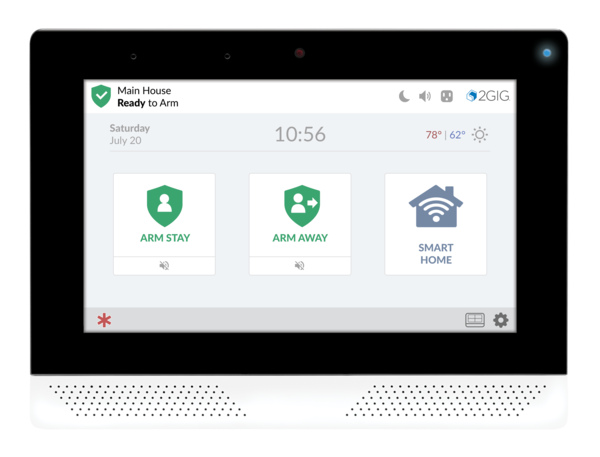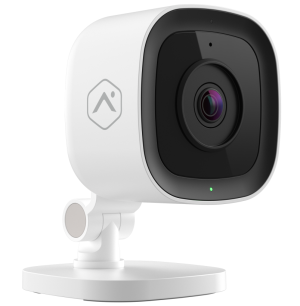2GIG Edge - Automatic Bluetooth Disarming
Posted By Michael GorisWe're back with more 2GIG Edge content today. First, if you haven't already seen our post about setting up 2GIG Edge Facial Recognition, then make sure to go check that out. We really want each new Edge user to get the most out of their system. But today's topic is Automatic Bluetooth Disarming.
 Whether you prefer to call it Automatic Bluetooth Disarming, Bluetooth Low Energy, Bluetooth LE, or whatever, it's a pretty cool feature for the new 2GIG Edge Alarm System. It's actually pretty similar to what Qolsys offers on the Qolsys IQ Panel 2 Plus. I personally found the 2GIG Edge Bluetooth Disarming feature a little bit easier to set up, though I will admit that I also found the options associated with the feature to be a bit lacking. And by that I mean, there aren't really any options for the feature, other than turning it ON or OFF, or as 2GIG likes to call it, ACTIVE or INACTIVE.
Whether you prefer to call it Automatic Bluetooth Disarming, Bluetooth Low Energy, Bluetooth LE, or whatever, it's a pretty cool feature for the new 2GIG Edge Alarm System. It's actually pretty similar to what Qolsys offers on the Qolsys IQ Panel 2 Plus. I personally found the 2GIG Edge Bluetooth Disarming feature a little bit easier to set up, though I will admit that I also found the options associated with the feature to be a bit lacking. And by that I mean, there aren't really any options for the feature, other than turning it ON or OFF, or as 2GIG likes to call it, ACTIVE or INACTIVE.
You should also keep in mind that only a maximum of five (5) phones can be set up with the feature, and you can only have one (1) phone paired per user. If you want to have the maximum 5 phones set up for Automatic Bluetooth Disarming, then they will need to be set up with 5 different users. And we also want to mention that the feature can only be used when the system is Armed Away. It won't work when the system is Armed Stay. But all of that aside, we'll just have a fairly quick post today, I'm just going to give you a quick rundown of setting up the feature and putting it into action.
First, to get started setting up 2GIG Edge Automatic Bluetooth Disarming, you need to access the Users Menu. Start from the main screen of the 2GIG Edge Panel. Click the small Settings Icon (the gear) in the bottom-right corner. Then enter in the Master Code (default 1111, but usually changed) or the Installer Code (default 1561, not usually changed), or use Facial Recognition if you have the feature set up for the Master User. Once inside, choose Users to access the Users Menu.
In the Users Menu, find the user you want to set up Automatic Bluetooth Disarming for. You can do it for the Master User or any other valid user. You cannot set it up for the Installer Code, which makes sense because the Installer Code cannot disarm the system. And you cannot configure it for the Duress Code either, as that would certainly lead to countless false alarms, which we obviously don't want. But in any case, decide on a user that CAN be set up for Automatic Bluetooth Disarming, and click the pencil icon next to the name to access the edit screen for that user.
As you go down the list, you will see options for Display Name, Access Code, Facial Recognition, Bluetooth Disarming, and User Number. Obviously, the one we want is Bluetooth Disarming. And when you click that, you will be taken to the Bluetooth Disarming Edit Screen for the user you selected.

At this time, you should turn ON your phone's Bluetooth feature. You will very shortly be putting the panel into a scanning mode where it can find pairable Bluetooth devices. Remember that you can only pair certain Bluetooth devices, namely smartphones. You won't be able to pair something like a tablet or a laptop. Again, this makes sense based on how the feature is used.
When you are ready, click the blue PAIR button on the right-hand side. Then press the green Scan button on the following screen. The Edge will begin scanning for a pairable Bluetooth device. If everything was done correctly on the Edge, and your phone is in its Bluetooth pairing mode, then it should appear. In our example, the Bluetooth device is called VELVET.

You should also notice a Bluetooth pairing request on your smartphone.

Once you click the Pair button on your phone, you will get the notification on the panel. Press the green Pair Device button to complete the process.


And that's pretty much it! You can make the feature ACTIVE or INACTIVE within the settings menu for the assigned user. When active, the feature will always be in effect. However, there is one exception. If the panel detects that the phone is still present when the system officially becomes armed - in other words, immediately after the Exit Delay has expired - then that phone will be barred from activating the feature for the current arming session. This is designed intentionally to prevent the panel from being accidentally disarmed prematurely because of a forgotten or left-behind phone. If you realize you forgot your phone before you left, then don't expect that phone to be able to activate the feature and disarm the system. But, the feature can still be activated by a different phone, as long as that phone was properly programmed and it was outside of wireless Bluetooth range of the panel when the Exit Delay expired. One other note is that the phone must be disconnected from the 2GIG Edge for ten (10) full seconds to prevent being barred from activating the feature for that arming session.
As we mentioned earlier, a maximum of five (5) users on the 2GIG Edge can be set up with the Automatic Bluetooth Disarming feature, and each user can only have one (1) paired phone. The feature will only work in Arm Away mode. It will not work when the system is Armed Stay. Activating the feature is quite simple. Your phone should automatically connect with the Edge once it gets into Bluetooth range. But the system won't actually go and automatically disarm until you activate a delay period by faulting an Entry/Exit Zone, or in other words, opening a door used for coming and going, such as a front door, back door, or garage door. For the feature to work properly, the phone must "connect" with the panel before the Entry Delay is triggered. And with the phone already connected, the system should disarm immediately upon activating the Entry/Exit Zone.
There is a timer so that the feature won't activate right away. This is to prevent you from accidentally activating the feature while you are still nearby after already arming the system. This timer is five (5) minutes. In other words, 5 minutes after you arm your system, once the system detects the paired Bluetooth device, if the system is in its Entry Delay window, it will disarm. It's super convenient, and it's good to see that 2GIG accounted for the possibility of a forgotten phone so that it does not create a security risk. But it is a bit questionable that there's no way to change or adjust the 5-minute timer. Maybe 2GIG can make this an adjustable setting in a future update? We would sure appreciate that!
When actually using the feature, it is advised that you check and make sure that the Bluetooth on your phone is reconnected before faulting the Entry/Exit Zone and activating the Entry Delay Period. If it's not reconnected to Bluetooth, then the feature will not work, and the system will not disarm automatically. We also want to say that to prevent false alarms, you should always be prepared for the possibility that the feature may fail. Be prepared to disarm with a valid code if needed. It's true that you can also disarm with Facial Recognition if that is set up, but you should always be prepared for the worst. Out of the three - Bluetooth, Facial Recognition, and classic code entry - classic code entry is still the most dependable. But we can also say that when testing the Bluetooth Disarming feature at Alarm Grid, it worked flawlessly.
Have you gotten to try out 2GIG Bluetooth Disarming yet? What do you think of the feature? Leave your thoughts in a comment down below. And stay tuned for more security system content on the Alarm Grid blog coming soon!!

















